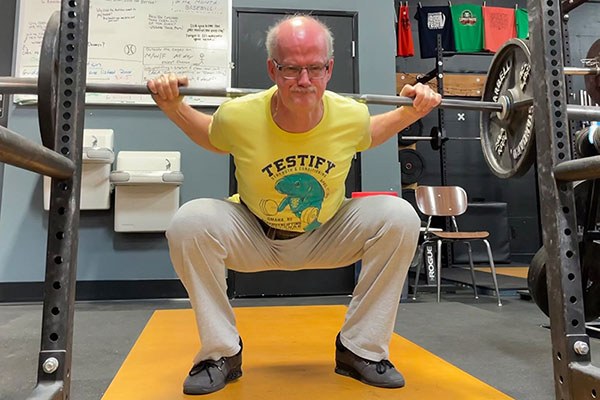
[adinserter block=”2″]
The Trifecta of Squat Cues
by Phil Meggers, SSC | April 25, 2023
The descent of your squat is important.
It should put you in a strong bottom position so that you can
effectively drive your hips out of the hole, so let’s discuss a cue
– really a trio of cues – that will help you achieve the correct
bottom position for your squat.
When teaching the squat, we start
without the bar, and the first task is to get you into the bottom
position. While you’re down there, we point out a few important
details about this position. Your hip crease is just below your
patella, you’re appropriately leaned over (i.e. your back angle is
relatively horizontal), and your femurs are pointing in the same
direction as your toes (and since we’ve already taught you to point
your toes out about thirty degrees, this means your femurs point in
that direction as well).
Now, how do we achieve this position?
You won’t hit this bottom position correctly without being taught,
so before you start your descent that very first time, we give you
some very explicit instructions. A few minutes later, when we put an
empty bar on your back for the first time, you’ll forget everything
you’ve just learned (don’t worry, this is normal), and so we give
you the same explicit instructions all over again.
These instructions are as follows: Hips
back. Chest down. Knees out.
This trio is the trifecta of squat
cues, the triumvirate, the triple crown – it doesn’t matter what
we call it, but it does matter that you know it. When cueing a lifter
(and this applies if you’re cueing yourself while under the bar),
we typically give one cue at a time, maybe two, so a trifecta of cues
starts to get a little long-winded. Cues should be concise so that
you don’t need to process a lot of information with a heavy weight
on your back, so if we use the trifecta in its entirety, we typically
use it during the teaching stage of the squat or during warm-ups. In
other words, we use it when you can spare the mental bandwidth needed
to think about and execute the movements. As the weight gets heavier,
we might use only one or two parts of the trifecta as needed.
With the trifecta, you are solving the
geometry problem created by taking your body and the barbell through
the squat’s long range of motion. To descend, you’ve got joints
and segments that need to get out of the way, so how do you do that?
You shove your knees out (specifically forward and out, but just
focus on the “out” part), you reach backward with your hips, and
you point your chest down.
When you shove your knees out (i.e,
sideways), you create space for your torso to fit between your
femurs. “Hips back” and “chest down” are two sides of the
same coin – if you reach your hips back without leaning over, you
fall over backward, and if you point your chest at the floor without
reaching back with your hips, you fall over forward. Falling in
either direction is rather counterproductive, so you simultaneously
reach back with your hips and point your chest down.
Try the trifecta out the next time you
squat. Your descent will be more efficient, and you will have set
yourself up for a strong ascent – you’ll have put yourself into
the correct bottom position, which means you’ll be able to
effectively drive your hips up out of the hole.
Hips back. Chest down. Knees out. Give
it a shot.
[adinserter block=”2″]
Credit : Source Post






